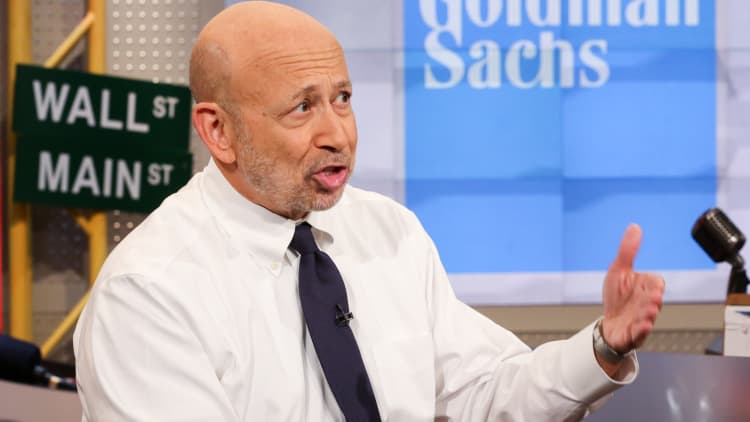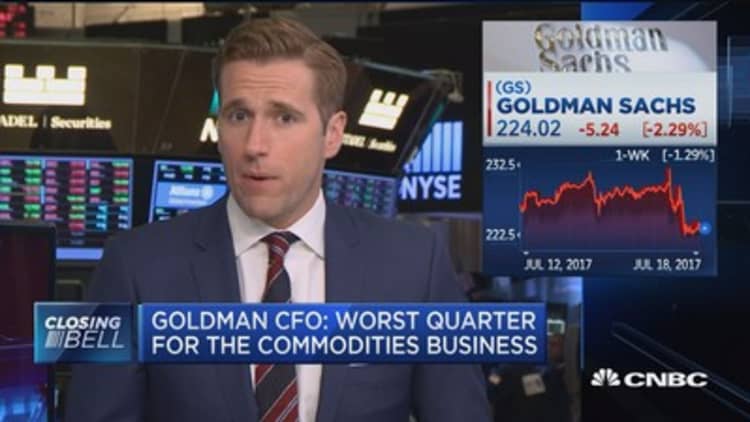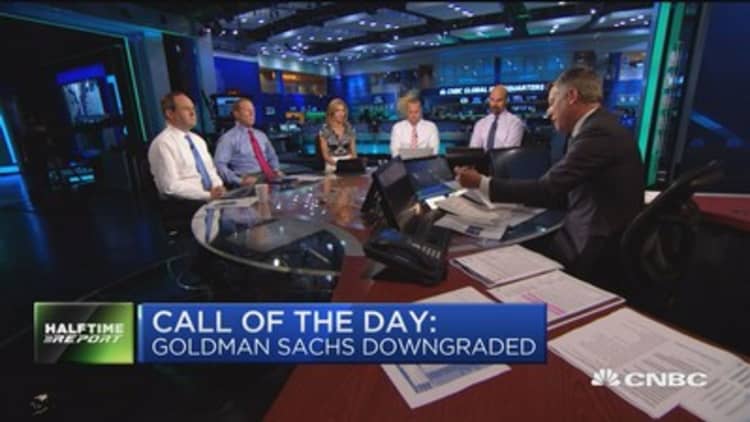
Goldman Sachs owes its poor trading performance this year at least in some part to a slew of wrong-way forecasts about the direction of markets.
The first half of 2017 saw Goldman's strategy team put out wrong calls about dollar and commodity strength and the expectation that government bond yields would be on a strong path higher.
Contrary to the forecasts, the dollar has slumped, commodities have taken a beating across the board and government bond yields have been held in check despite more aggressive policy from the Federal Reserve.
Results through the second quarter in Goldman's trading business followed suit.
After a 2 percent annualized decline in first-quarter trading revenue, the number plunged 17 percent in the second quarter, according to Tuesday's earnings report. That included a stunning 40 percent slide in the closely watched fixed income, currencies and commodities category. Commodities had their worst quarter ever.

"They're sharing the pain with their clients. That's not a good thing," said one analyst who asked not to be identified.
The company's stock fell 2.6 percent Tuesday and nudged higher Wednesday.
While Wall Street is not giving up on a bank that posted otherwise strong results on both profit and revenue, the struggles through 2017 are drawing notice. Several analysts downgraded Goldman shares or reduced targets for price or earnings, over concern about the firm's fundamental direction.
"To the extent that Goldman Sachs is unable to improve its results in FICC relative to peers over the next several quarters without increasing its risk profile, it could indicate some deterioration of the firm's franchise strength and would be a credit negative development," ratings agency Moody's said in a research note.
A look at some of the more notable wrong calls from Goldman strategists this year:
- In January, the firm proclaimed on its website that "demand drives a positive outlook" for oil. By late June, Goldman had to recant, even though it still insisted the fundamental picture for crude was still strong even though cyclical factors had lined up against the trade. Year to date, the commodity has fallen about 12 percent. Commodities overall, as gauged by the iShares S&P GSCI Commodity- Indexed Trust ETF, are down nearly 10 percent.
- One of Goldman's top calls for 2017 was a strong dollar against the euro, sterling and yuan, based on an expectation for a big reflation trade in the U.S. Wrong again. By April, Goldman was closing its long-dollar positions. Year to date, the dollar index, which measures the greenback against a basket of global peers, has fallen more than 7 percent.
- Along the same lines, the firm saw a big reversal in a seemingly endless bull market for bonds. Goldman predicted the reflation trade along with a more hawkish Fed would boost the yield on the benchmark 10-year Treasury note to hit 3 percent this year. That also has gone awry. The 10-year is currently trading around 2.26 percent and the price — which moves opposite yields — is up more than 5 percent year to date.
The one bright spot for Goldman's trade picture has been equities, which rose 8 percent in the second quarter. The firm has been tepid on stocks this year, with strategist David Kostin recently raising his price target for the from 2,300 to 2,400. The index is up nearly 10 percent this year and is trading above the Goldman target.
Of course, the year is barely six months old and Goldman has time to recover. A return of market volatility would help, though analysts aren't sure that would be enough. The firm has stuck with the commodities part of the business for years even while its peers retreated from a sector in which it has proven increasingly tough to turn a strong profit.
"We believe that even if we move to a better trading environment ... GS may not see market share gains since it is unclear whether the company would be positioned right if revenues increase or whether the right mix of clients sees better activity," analysts at Keefe, Bruyette & Woods said in a research note in which they cut Goldman to market perform and reduced the 12-month price target on the stock to $230, or slightly above its current level.
Goldman did not respond to a request for comment.
However, Chief Financial Officer Martin Chavez told analysts on a conference call Tuesday that the firm realizes it has "to do better" at some basic levels of performance.
"So much of it is blocking and tackling," Chavez said. "The ongoing question in every business generally is 'How can we do better with the clients of the firm? How can we cover them better? How can we have a greater impact with them? How can we provide them new solutions to their challenges?' That is really an iterative process of communicating with the clients. Our business starts and ends with them."
WATCH: Lower expectations for trading revenue



